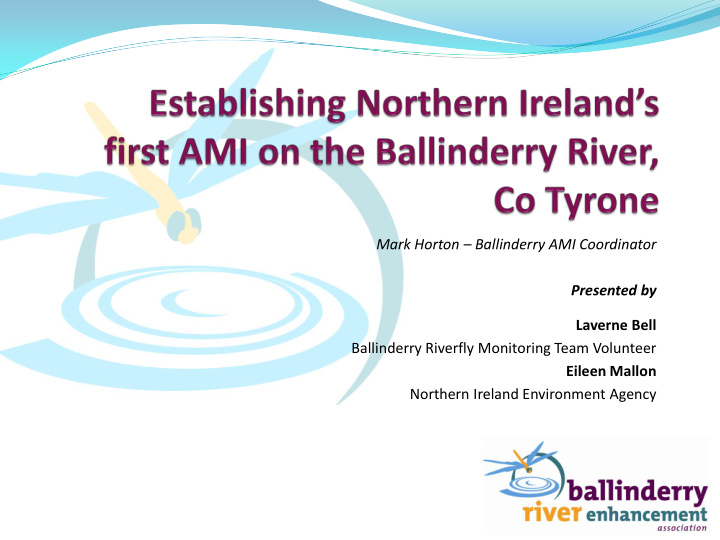



Mark Horton – Ballinderry AMI Coordinator Presented by Laverne Bell Ballinderry Riverfly Monitoring Team Volunteer Eileen Mallon Northern Ireland Environment Agency
The Ballinderry River, Co. Tyrone County Tyrone/Londonderry International RBD Neagh-Bann Catchment Area 480 km 2 Main Channel Length 47 km Source Camlough – Sperrin Mountains Mouth Lough Neagh Urban Centre Cookstown Catchment Population ~33,000
A catchment of diverse land use 49.5% - Improved grassland 10.2% - Arable horticulture 37% - Unimproved (peat bog, heath, woodland) 2.3% - Continuous urban and suburban rural development 1% - Inland water
A very important 1%...but why? Upper Ballinderry River Area of Special Scientific Interest (ASSI) Upper Ballinderry River Special Area of Conservation (SAC) Natura 2000 site Lough Neagh Wetlands RAMSAR (Iran 1971) Internationally important site for migratory wildfowl Otter Freshwater Pearl Mussel Stream Water-crowfoot
Ancient woodland The largest oak tree in Ireland, the Drumond Oak, is on the banks of the Ballinderry River at Killymoon Castle, near Cookstown
Wet woodland Home to many important bird species and mammals
Kingfisher Alcedo atthis There a good populations of Kingfisher throughout the Ballinderry River system
White-clawed crayfish Austropotamobius pallipes The Ballinderry is the most northerly river in Ireland known to have white-clawed crayfish
Atlantic salmon Salmo salar By the time salmon run from the Atlantic, up the River Bann, into Lough Neagh and up the Ballinderry they have lost their silver colour and are pink and brown
River brown trout & dollaghan trout Salmo trutta Dollaghan, unique to the Lough Neagh Rivers, migrate to the lough before returning as adults to the river to spawn. Brown trout spend their whole lives in the river.
Just some examples of the pressures
Diffuse and point source agricultural pollution With 60% of the catchment in agricultural use poor farming practices have the potential to make a big impact
Serious pollution events In October 2010 an entire above-ground slurry store containing pig slurry emptied into a tributary of the river system. These events are thankfully rare but have a devastating impact on the river and its wildlife.
Underperforming Wastewater Treatment Works February 2011 – Cookstown WwTW discharges raw sewage into the Ballinderry due to misconnections in the storm water and sewerage network. This is after a £14 million improvement scheme to the plant.
Poor planning decisions Building too close to the river left this newly built house teetering on the edge of the river. It’s oil tank was washed into the river – thankfully it had not been filled with oil.
Industrial pollution Dirty water run-off and chemical pollution have the potential to at least clog up fish spawning gravel and mussel beds ... at worst they result in major ecological wipe- outs.
Illegal fuel laundering and dumping January 2009 - Cat litter, used to strip the red dye out of agricultural diesel, has been dumped near the river . Diesel seeping out of the cat litter makes its way into nearby water courses.
Ballinderry River Enhancement Association An association set up in 1984 to tackle the problems of... Declining numbers of fish Degrading water quality Habitat destruction Now a charity and part of the Association of Rivers Trusts Carries out projects to... Improve water quality Breed locally endangered species Restore habitat Educate the community Today represents 8 angling clubs 2 river ‘clean - up’ groups 1 canoe club
Why the need for an AMI on the Ballinderry? Ongoing intermittent and persistent pollution pressures in the catchment – AMI means more eyes on the river Identified the need for a ‘local’ water quality monitoring group through a community-led river action plan (RIPPLE) NIEA operational monitoring is being reduced from annual to 3-year rolling programme due to resource constraints
Setting up NI’s first AMI January 2010 – BREA/RP/NIEA initial meeting Pilot project agreed Pilot project is supporting WFD Local Management Area Plan for Ballinderry June 2010 – BREA secures funding - National Lottery’s Big Lottery Fund Equipment/training for 24 volunteers GIS to pilot recording of data spatially – first for AMI Minister for the Environment, Mr Edwin Poots MLA, announces at Stormont that his Department is supporting the pilot
Training the volunteers October 2010 - First 12 volunteers trained by the RP NIEA representatives invited observe training Volunteers identify potential sampling points - visited by the AMI Coordinator Approved sites’ details sent to NIEA for Trigger Levels to be set Last 12 volunteers to be trained by RP May/June 2011
NIEA’s regular statutory monitoring network OSNI map
Ballinderry AMI sites so far (first 12 volunteers) OSNI map
Combined NIEA/AMI monitoring network OSNI map
January 2011 Data starts to come in...
Making the AMI work in Northern Ireland Protocol for AMI breaches tailored to NI NIEA staff briefed on AMI Breeches reported directly to Pollution Hotline Breeches may help target further investigative river walks Continuous low scoring sites to be investigated by BREA and/or NIEA Tackle the causes of invert suppression Review trigger levels Spatially mapped AMI data shared with NIEA to inform river basin planning process
The future of the AMI in Northern Ireland... Seminars and regular meetings between BREA/NIEA on progress June 2011 - Review of Ballinderry AMI Pilot NIEA resource commitment / Gains from volunteer commitment Value of AMI and its application in NI Outcome – recommendations on a way forward Already interest from the Six Mile Water Trust, Angling Clubs (inc. Ulster Angling Fed.) and wildlife groups Partnership is key – BREA/ART/RP/NIEA working together, sharing learning, knowledge and expertise, working towards a common goal.
A special thank you to the funders and supporters
Recommend
More recommend